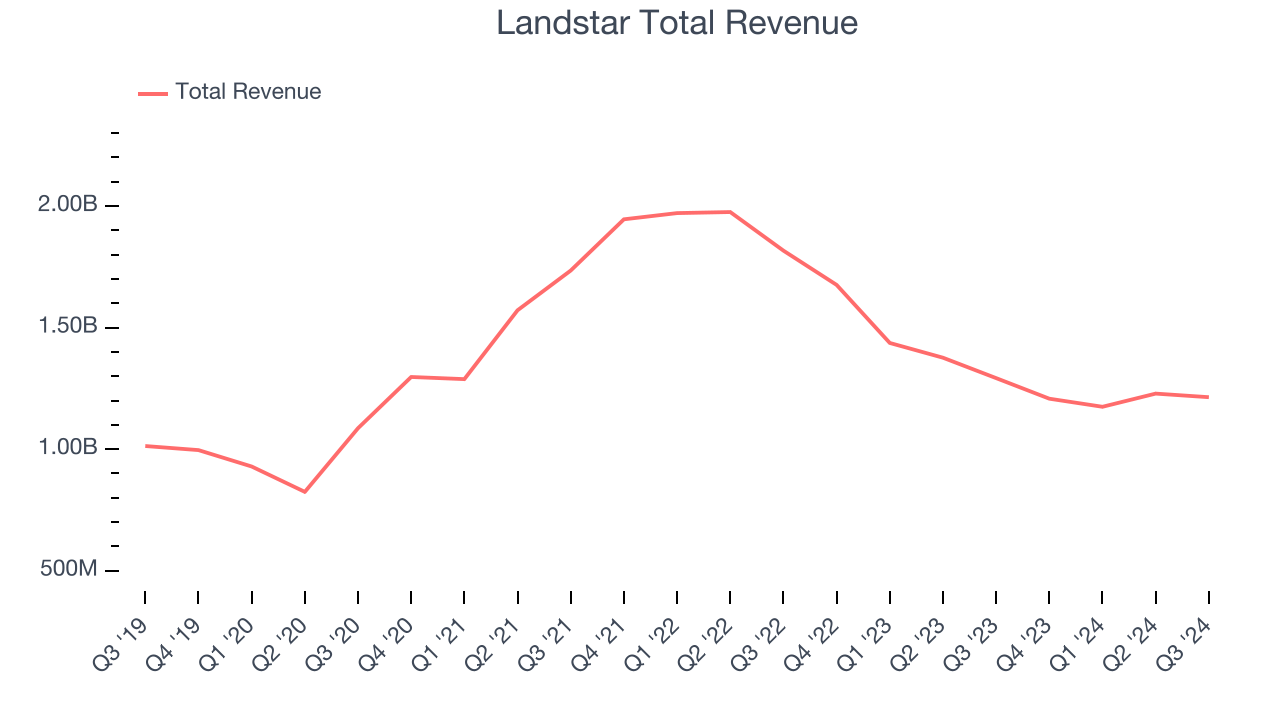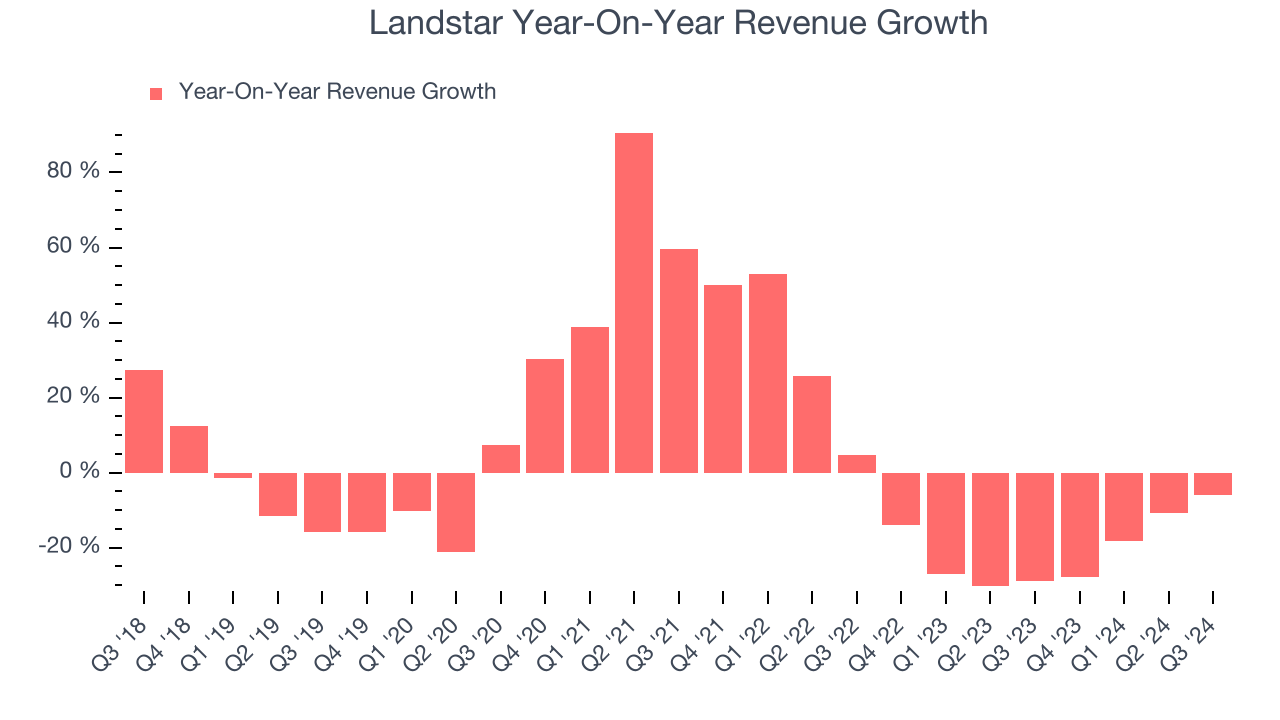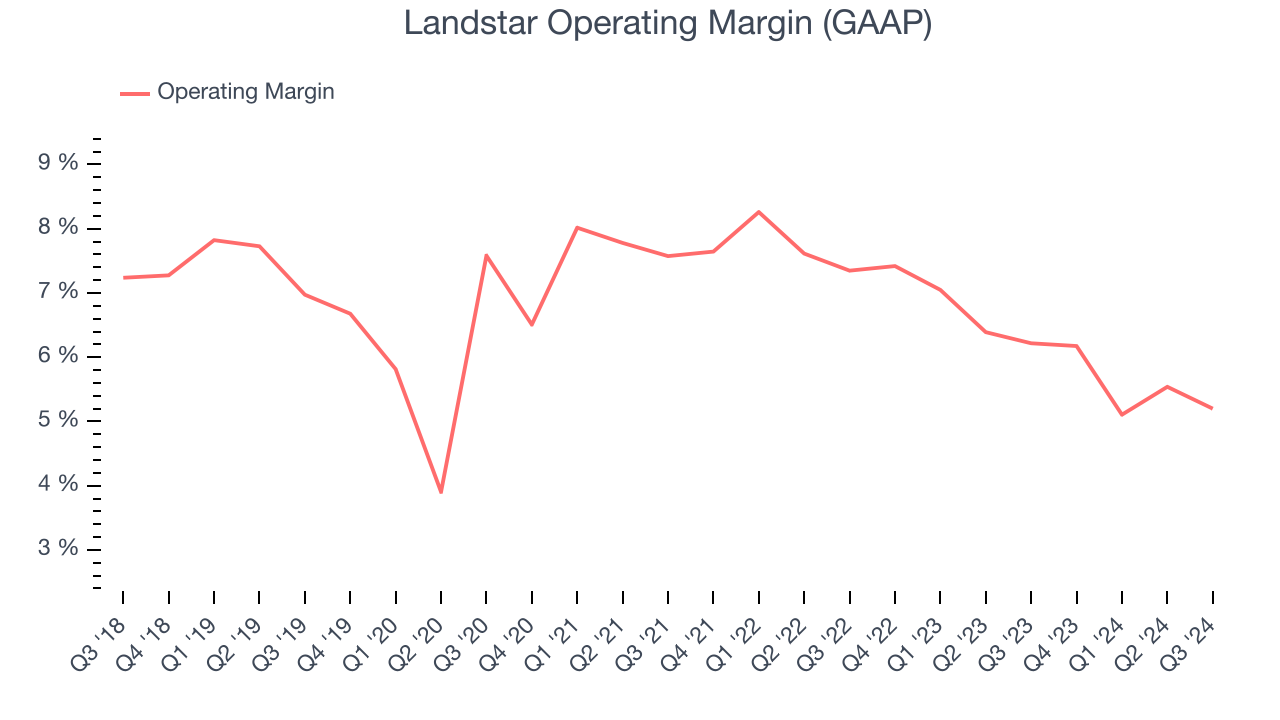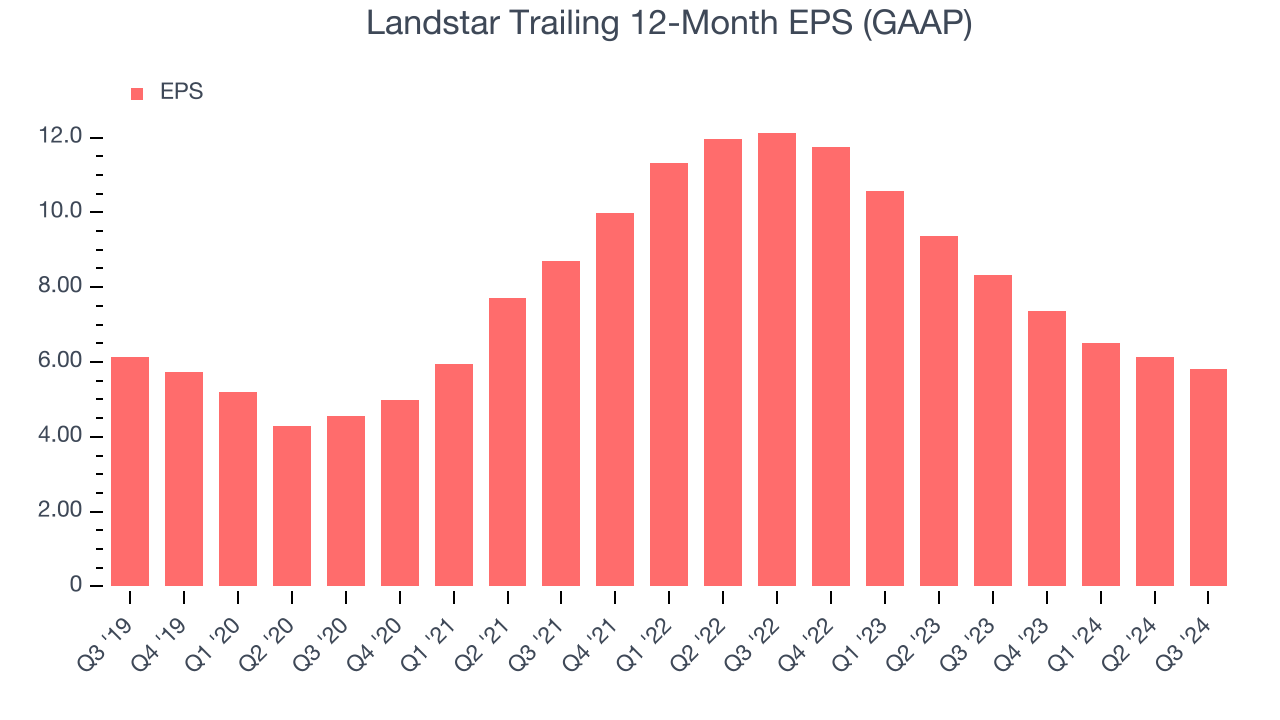
Freight delivery company Landstar (NASDAQ: LSTR) met Wall Street’s revenue expectations in Q3 CY2024, but sales fell 6.1% year on year to $1.21 billion. Its GAAP profit of $1.41 per share was 2.4% below analysts’ consensus estimates.
Is now the time to buy Landstar? Find out by accessing our full research report, it’s free.
Landstar (LSTR) Q3 CY2024 Highlights:
- Revenue: $1.21 billion vs analyst estimates of $1.22 billion (slight miss)
- EPS: $1.41 vs analyst expectations of $1.45 (2.4% miss)
- Gross Margin (GAAP): 22.2%, in line with the same quarter last year
- Operating Margin: 5.2%, down from 6.2% in the same quarter last year
- Market Capitalization: $6.44 billion
JACKSONVILLE, Fla., Oct. 29, 2024 (GLOBE NEWSWIRE) -- Landstar System, Inc. (NASDAQ: LSTR) (“Landstar” or the “Company”) today reported basic and diluted earnings per share (“EPS”) of $1.41 in the 2024 third quarter on revenue of $1.214 billion.
Company Overview
Covering billions of miles throughout North America, Landstar (NASDAQ: LSTR) is a transportation company specializing in freight and last-mile delivery services.
Ground Transportation
The growth of e-commerce and global trade continues to drive demand for shipping services, especially last-mile delivery, presenting opportunities for ground transportation companies. The industry continues to invest in data, analytics, and autonomous fleets to optimize efficiency and find the most cost-effective routes. Despite the essential services this industry provides, ground transportation companies are still at the whim of economic cycles. Consumer spending, for example, can greatly impact the demand for these companies’ offerings while fuel costs can influence profit margins.
Sales Growth
A company’s long-term performance is an indicator of its overall business quality. While any business can experience short-term success, top-performing ones enjoy sustained growth for multiple years. Over the last five years, Landstar grew its sales at a sluggish 2.4% compounded annual growth rate. This shows it failed to expand in any major way, a rough starting point for our analysis.

We at StockStory place the most emphasis on long-term growth, but within industrials, a half-decade historical view may miss cycles, industry trends, or a company capitalizing on catalysts such as a new contract win or a successful product line. Landstar’s history shows it grew in the past but relinquished its gains over the last two years, as its revenue fell by 20.9% annually. Landstar isn’t alone in its struggles as the Ground Transportation industry experienced a cyclical downturn, with many similar businesses seeing lower sales at this time. 
We can dig further into the company’s revenue dynamics by analyzing its most important segments, Van Equipment and Platform Equipment, which are 49.8% and 30.5% of revenue. Over the last two years, Landstar’s Van Equipment revenue (full truckload van transportation) averaged 21.4% year-on-year declines while its Platform Equipment revenue (full truckload trailer transportation) averaged 9.8% declines.
This quarter, Landstar reported a rather uninspiring 6.1% year-on-year revenue decline to $1.21 billion of revenue, in line with Wall Street’s estimates.
Looking ahead, sell-side analysts expect revenue to grow 8.5% over the next 12 months, an improvement versus the last two years. This projection is above the sector average and illustrates the market believes its newer products and services will fuel higher growth rates.
Unless you’ve been living under a rock, it should be obvious by now that generative AI is going to have a huge impact on how large corporations do business. While Nvidia and AMD are trading close to all-time highs, we prefer a lesser-known (but still profitable) semiconductor stock benefitting from the rise of AI. Click here to access our free report on our favorite semiconductor growth story.
Operating Margin
Operating margin is an important measure of profitability as it shows the portion of revenue left after accounting for all core expenses–everything from the cost of goods sold to advertising and wages. It’s also useful for comparing profitability across companies with different levels of debt and tax rates because it excludes interest and taxes.
Landstar was profitable over the last five years but held back by its large cost base. Its average operating margin of 6.9% was weak for an industrials business. This result isn’t too surprising given its low gross margin as a starting point.
Looking at the trend in its profitability, Landstar’s annual operating margin might have seen some fluctuations but has generally stayed the same over the last five years, which doesn’t help its cause.

This quarter, Landstar generated an operating profit margin of 5.2%, down 1 percentage points year on year. Since Landstar’s operating margin decreased more than its gross margin, we can assume it was recently less efficient because expenses such as marketing, R&D, and administrative overhead increased.
Earnings Per Share
We track the long-term change in earnings per share (EPS) for the same reason as long-term revenue growth. Compared to revenue, however, EPS highlights whether a company’s growth was profitable.
Sadly for Landstar, its EPS declined by 1% annually over the last five years while its revenue grew by 2.4%. However, its operating margin didn’t change during this timeframe, telling us that non-fundamental factors affected its ultimate earnings.

Like with revenue, we analyze EPS over a shorter period to see if we are missing a change in the business.
For Landstar, its two-year annual EPS declines of 30.7% show it’s continued to underperform. These results were bad no matter how you slice the data.In Q3, Landstar reported EPS at $1.41, down from $1.71 in the same quarter last year. This print missed analysts’ estimates. Over the next 12 months, Wall Street expects Landstar’s full-year EPS of $5.82 to grow by 19.7%.
Key Takeaways from Landstar’s Q3 Results
Revenue missed slightly and EPS missed by a more noticeable amount. Holding aside Wall Street expectations, operating margin fell year on year. Overall, this was a weaker quarter. The stock remained flat at $180.57 immediately after reporting.
Big picture, is Landstar a buy here and now?We think that the latest quarter is only one piece of the longer-term business quality puzzle. Quality, when combined with valuation, can help determine if the stock is a buy. We cover that in our actionable full research report which you can read here, it’s free.






